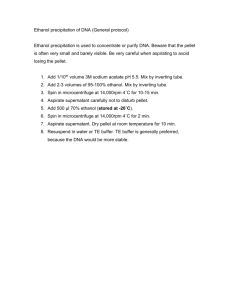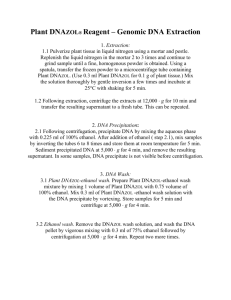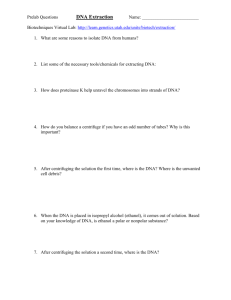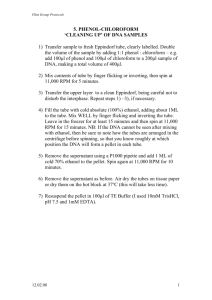EXTRACTION OF PROTEIN AND DNA USING THE TRIZOL
advertisement
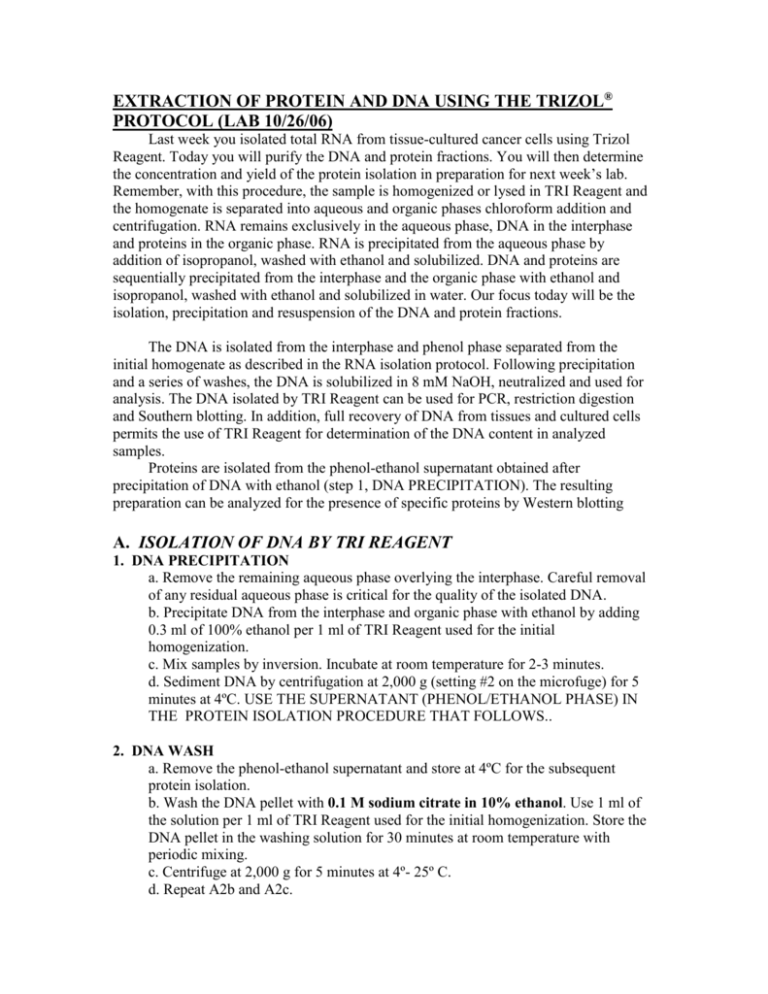
EXTRACTION OF PROTEIN AND DNA USING THE TRIZOL® PROTOCOL (LAB 10/26/06) Last week you isolated total RNA from tissue-cultured cancer cells using Trizol Reagent. Today you will purify the DNA and protein fractions. You will then determine the concentration and yield of the protein isolation in preparation for next week’s lab. Remember, with this procedure, the sample is homogenized or lysed in TRI Reagent and the homogenate is separated into aqueous and organic phases chloroform addition and centrifugation. RNA remains exclusively in the aqueous phase, DNA in the interphase and proteins in the organic phase. RNA is precipitated from the aqueous phase by addition of isopropanol, washed with ethanol and solubilized. DNA and proteins are sequentially precipitated from the interphase and the organic phase with ethanol and isopropanol, washed with ethanol and solubilized in water. Our focus today will be the isolation, precipitation and resuspension of the DNA and protein fractions. The DNA is isolated from the interphase and phenol phase separated from the initial homogenate as described in the RNA isolation protocol. Following precipitation and a series of washes, the DNA is solubilized in 8 mM NaOH, neutralized and used for analysis. The DNA isolated by TRI Reagent can be used for PCR, restriction digestion and Southern blotting. In addition, full recovery of DNA from tissues and cultured cells permits the use of TRI Reagent for determination of the DNA content in analyzed samples. Proteins are isolated from the phenol-ethanol supernatant obtained after precipitation of DNA with ethanol (step 1, DNA PRECIPITATION). The resulting preparation can be analyzed for the presence of specific proteins by Western blotting A. ISOLATION OF DNA BY TRI REAGENT 1. DNA PRECIPITATION a. Remove the remaining aqueous phase overlying the interphase. Careful removal of any residual aqueous phase is critical for the quality of the isolated DNA. b. Precipitate DNA from the interphase and organic phase with ethanol by adding 0.3 ml of 100% ethanol per 1 ml of TRI Reagent used for the initial homogenization. c. Mix samples by inversion. Incubate at room temperature for 2-3 minutes. d. Sediment DNA by centrifugation at 2,000 g (setting #2 on the microfuge) for 5 minutes at 4ºC. USE THE SUPERNATANT (PHENOL/ETHANOL PHASE) IN THE PROTEIN ISOLATION PROCEDURE THAT FOLLOWS.. 2. DNA WASH a. Remove the phenol-ethanol supernatant and store at 4ºC for the subsequent protein isolation. b. Wash the DNA pellet with 0.1 M sodium citrate in 10% ethanol. Use 1 ml of the solution per 1 ml of TRI Reagent used for the initial homogenization. Store the DNA pellet in the washing solution for 30 minutes at room temperature with periodic mixing. c. Centrifuge at 2,000 g for 5 minutes at 4º- 25º C. d. Repeat A2b and A2c. e. Suspend the DNA pellet in 75% ethanol (1.5-2 ml of 75% ethanol per 1 ml TRI REAGENT) f. Incubate for 15 min at room temperature with periodic mixing. g. Centrifuge at 2,000 g for 5 minutes at 4-25º C. This ethanol wash should remove the pinkish color from the DNA pellet. An additional wash in 0.1M trisodium citrate-10% ethanol is required for large pellets containing >200 µg DNA or large amounts of a non-DNA material. 3. DNA SOLUBILIZATION a. Remove the ethanol wash and briefly air-dry the DNA pellet by keeping tubes open for 3 - 5 minutes at room temperature. b. Dissolve the DNA pellet in 0.4 ml 8 mM NaOH by slowly passing through a pipette. The use of a mild alkaline solution assures full solubilization of the DNA pellet. At this stage, the DNA preparations (especially from tissues) still contain insoluble material (fragments of membranes,etc.); remove this material by centrifugation at 12,000 g for 10 minutes and transfer the resulting supernatant containing DNA to new tubes. A high viscosity of the supernatant indicates the presence of high molecular weight DNA. QUANTITATION OF DNA a. Quantitate as in previous experiments. b. Expected yield: 5-7 ug DNA/106 cells. B. ISOLATION OF PROTEIN BY TRI REAGENT-- Proteins are isolated from the phenol-ethanol supernatant obtained after precipitation of DNA with ethanol (step 1, DNA PRECIPITATION). The resulting preparation can be analyzed for the presence of specific proteins by Western blotting. 1. PROTEIN PRECIPITATION a. Aliquot 300 µl of the supernatant from step “A1b” (above) into a microfuge tube. b. Precipitate proteins by adding 3 volumes of acetone. c. Mix by inversion for 10-15 sec to obtain a homogeneous solution. d. Store samples for 10 min at room temperature and sediment the protein precipitate at top speed in the µfuge for 10 min at 4ºC. 2. PROTEIN WASH a. Discard the supernatant and disperse the protein pellet in 0.5 ml of 0.3 M guanidine hydrochloride in 95% ethanol + 2.5 % glycerol (1:1). b. Disperse the pellet using a pestle or pipette tip. c. After dispersing the pellet, add another 0.5 ml of the guanidine hydrochloride/ethanol/glycerol wash solution to the sample and incubate for 10 min at RT. d. Sediment the protein at setting #8 (8,000 g) for 5 min. e. Decant the wash solution and perform two more washes with incubations and spins in 1 ml each of the guanidine/ethanol/glycerol wash solution. f. Disperse the pellet by vortexing after each wash to efficiently remove residual phenol. g. Perform the final wash in 1 ml of ethanol containing 2.5 % glycerol (V:V). Incubate at room temperature for 10 minutes. h. Sediment the protein at 8,000 g for 5 minutes. i. Decant the alcohol, invert the tube and dry the pellet for 7-10 min at room temperature. 3. PROTEIN SOLUBILIZATION a. After briefly air-drying the protein pellet, add 200 µl 1% SDS. b. Gently disperse and solubilize the pellet for 15-20 minutes by "flicking" the tube or pipetting as required. c. Store and label the solubilized protein at -20ºC. We will use the extract for western analysis.
